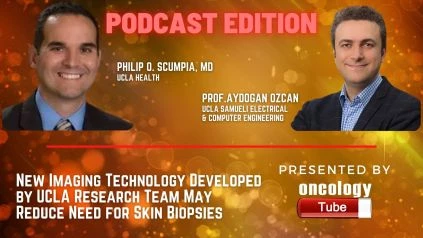Philip O. Scumpia, MD, Ph.D. and Professor Aydogan Ozcan, Ph.D. from UCLA Health and UCLA Samueli Electrical & Computer Engineering speak about New Imaging Technology Developed by UCLA Research Team May Reduce Need for Skin Biopsies.
Link to Article:
https://samueli.ucla.edu/new-imaging-technology-developed-by-ucla-research-team-may-reduce-need-for-skin-biopsies/
Your dermatologist takes photographs of a suspicious-looking lesion and rapidly produces a detailed, microscopic image of the skin instead of surgically extracting a sample of skin, sending it to a lab, and waiting several days for findings.
According to a new article published today in Light: Science & Applications, a journal of the Springer Nature Group, this could become commonplace in clinics as a result of a new “virtual histology” technology developed by UCLA researchers at the Samueli School of Engineering and the David Geffen School of Medicine. Histology is the study of tissue structure at the microscopic level.
The technology, which has been under development for more than three years, could open up new avenues for the quick diagnosis of malignant skin tumors, lowering the frequency of unnecessary invasive skin biopsies and allowing for earlier skin cancer diagnosis. This method had previously only been used on microscopy slides containing unstained tissue obtained through a biopsy. This is the first time virtual histology has been used on intact, non-biopsied tissue.
The research team, led by Ozcan, Scumpia, and Dr. Gennady Rubinstein of the Dermatology & Laser Centre in Los Angeles, developed a deep-learning framework to convert images of intact skin captured by an emerging noninvasive optical technology called reflectance confocal microscopy (RCM) into a format that dermatologists and pathologists can understand. Because RCM images are in black and white, and unlike ordinary histology, they lack nuclear characteristics of cells, analyzing them takes particular knowledge.
The researchers used a “convolutional neural network” to quickly convert RCM photos of unstained skin into virtually stained 3D images similar to the H&E (hematoxylin and eosin) images that dermatologists and dermatopathologists are familiar with. Deep learning, a type of machine learning, creates artificial neural networks that can “learn” from enormous amounts of data in the same way that the human brain can.
This is a fascinating proof-of-concept study, according to Rubinstein. “Dermatoscopes, which magnify skin and polarize light, is now the only tool used in clinics to assist dermatologists. “At most, they can assist a dermatologist in identifying patterns,” said Rubinstein, who also utilizes reflectance confocal microscopes in his practice.
Several steps remain in adapting this technology for clinical application, according to the authors, but their ultimate goal is to create virtual histology technology that can be integrated into any device, large or tiny, or paired with other optical-imaging systems. Once the neural network has been “trained” with a large number of tissue samples and powerful graphics processing units (GPUs), it can be run on a computer or network, allowing quick transformation from a conventional image to a virtual histology image.
Future research will see if this digital, biopsy-free technique can be combined with whole-body imaging and electronic medical data to usher in a new era of “digital dermatology” and revolutionize dermatology. The researchers will also see if this artificial intelligence platform can be used in conjunction with other AI technologies to seek patterns and aid in clinical diagnosis.
Jingxi Li, Jason Garfinkel, Xiaoran Zhang, Di Wu, Yijie Zhang, Kevin de Haan, Hongda Wang, Tairan Liu, and Bijie Bai are among the other authors of this paper, as are electrical and computer engineering assistant adjunct professor Yair Rivenson of UCLA Samueli and Ozcan’s engineering graduate students: Jingxi Li, Jason Garfinkel, Xiaoran Zhang, Di Wu, Yijie
The National Science Foundation’s Biophotonics Program is funding the study (PI: Ozcan). Scumpia got a VA Merit Award in conjunction with Ozcan to explore biopsy-free virtual histology in non-melanoma skin cancer in veterans.

